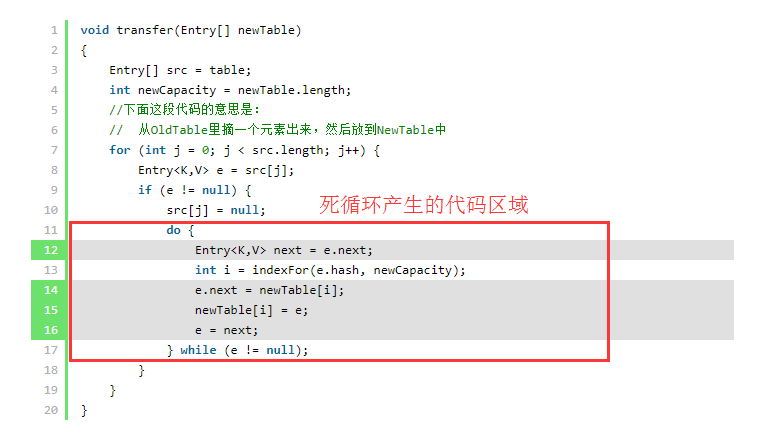1 一切需要從HashMap屬性字段說起:
|
1
2
3
4
5
6
7
8
9
10
11
12
13
14
15
16
17
18
19
20
21
22
23
24
25
26
27
28
29
30
31
32
33
34
35
36
37
38
39
40
41
42
43
44
45
46
47
48
49
50
51
52
53
54
55
56
57
58
59
60
61
62
63
64
65
|
/** The default initial capacity - MUST be a power of two. 初始容量 */ static final int DEFAULT_INITIAL_CAPACITY = 1 << 4; // aka 16 /** * The maximum capacity, used if a higher value is implicitly specified * by either of the constructors with arguments. * MUST be a power of two <= 1<<30. 最大容量 */ static final int MAXIMUM_CAPACITY = 1 << 30; /** * The load factor used when none specified in constructor. * 默認的負載因子,當map的size>=負載因子*capacity時候并且插入元素時候的table[i]!=null進行擴容 * 擴容判斷邏輯:java.util.HashMap#addEntry函數中 * */ static final float DEFAULT_LOAD_FACTOR = 0.75f; /** * An empty table instance to share when the table is not inflated. */ static final Entry<?,?>[] EMPTY_TABLE = {}; /** * The table, resized as necessary. Length MUST Always be a power of two. 哈希表 */ transient Entry<K,V>[] table = (Entry<K,V>[]) EMPTY_TABLE; /** * The number of key-value mappings contained in this map. map的大小 */ transient int size; /** * The next size value at which to resize (capacity * load factor). * @serial */ // If table == EMPTY_TABLE then this is the initial capacity at which the // table will be created when inflated. 擴容的閾值 = capacity * 負載因子 int threshold; /** * The load factor for the hash table. 負載因子,默認是0.75,可以在創建HashMap時候通過構造函數指定 * * @serial */ final float loadFactor; /** * The number of times this HashMap has been structurally modified * Structural modifications are those that change the number of mappings in * the HashMap or otherwise modify its internal structure (e.g., * rehash). This field is used to make iterators on Collection-views of * the HashMap fail-fast. (See ConcurrentModificationException). * 修改次數:例如進行rehash或者返回hashMap視圖時候如果發生修改可以fast-fail */ transient int modCount; /** * The default threshold of map capacity above which alternative hashing is * used for String keys. Alternative hashing reduces the incidence of * collisions due to weak hash code calculation for String keys. * <p/> * This value may be overridden by defining the system property * {@code jdk.map.althashing.threshold}. A property value of {@code 1} * forces alternative hashing to be used at all times whereas * {@code -1} value ensures that alternative hashing is never used. * rehash時候判斷的一個閾值 */ static final int ALTERNATIVE_HASHING_THRESHOLD_DEFAULT = Integer.MAX_VALUE; |
2: 接下來查看一下HashMap的put方法:
|
1
2
3
4
5
6
7
8
9
10
11
12
13
14
15
16
17
18
19
20
21
22
23
24
25
26
27
28
29
30
31
32
33
34
35
36
37
|
/** * Associates the specified value with the specified key in this map. * If the map previously contained a mapping for the key, the old * value is replaced. * * @param key key with which the specified value is to be associated * @param value value to be associated with the specified key * @return the previous value associated with <tt>key</tt>, or * <tt>null</tt> if there was no mapping for <tt>key</tt>. * (A <tt>null</tt> return can also indicate that the map * previously associated <tt>null</tt> with <tt>key</tt>.) */ public V put(K key, V value) { if (table == EMPTY_TABLE) {//初始化哈希表 inflateTable(threshold); } if (key == null) //如果key 為null 存儲到table[0]位置 return putForNullKey(value); int hash = hash(key); //計算hash值 int i = indexFor(hash, table.length);//計算entry在table中的位置 //for循環邏輯用于修改key對應的value的 for (Entry<K,V> e = table[i]; e != null; e = e.next) { Object k; if (e.hash == hash && ((k = e.key) == key || key.equals(k))) { V oldValue = e.value; e.value = value; e.recordAccess(this); return oldValue;//如果是更新返回舊值 } } //修改次數++ modCount++; //添加元素到哈希表中 addEntry(hash, key, value, i); // 如果是添加元素則返回null return null; } |
3 put中調用的inflateTable方法:
|
1
2
3
4
5
6
7
8
9
10
11
12
13
14
|
/** * Inflates the table. */ private void inflateTable(int toSize) { // Find a power of 2 >= toSize //計算大于等于toSize的最小的2的整數次冪的值 int capacity = roundUpToPowerOf2(toSize); //計算擴容閾值 threshold = (int) Math.min(capacity * loadFactor, MAXIMUM_CAPACITY + 1); //初始化哈希表 table = new Entry[capacity]; //更新一下rehash的判斷條件,便于以后判斷是否rehash initHashSeedAsNeeded(capacity); } |
4 put方法中調用的indexFor方法:
|
1
2
3
4
5
6
7
8
|
/** * Returns index for hash code h. 返回哈希值對應的哈希表索引 */ static int indexFor(int h, int length) { // assert Integer.bitCount(length) == 1 : "length must be a non-zero power of 2"; //使用&操作,而不使用取余原因:均勻分布在哈希表中 。length-1目的是:由于table的長度都是2的整數次冪進行擴容,length-1的二進制全是1,計算效率高 return h & (length-1); } |
5 put方法中調用的addEntry方法:
|
1
2
3
4
5
6
7
8
9
10
11
12
13
14
15
16
17
18
|
/** * Adds a new entry with the specified key, value and hash code to * the specified bucket. It is the responsibility of this * method to resize the table if appropriate. * * Subclass overrides this to alter the behavior of put method. */ void addEntry(int hash, K key, V value, int bucketIndex) { //判斷是否擴容,只有size大于等于閾值而且當前插入table[i]!=null(就是able[i]已經被占用則擴容) if ((size >= threshold) && (null != table[bucketIndex])) { resize(2 * table.length); hash = (null != key) ? hash(key) : 0; //如果需要擴容的話則需要更新再次重新計算哈希表位置 bucketIndex = indexFor(hash, table.length); } //將值插入到哈希表中 createEntry(hash, key, value, bucketIndex); } |
6 addEntry方法中調用的createEntry方法:
|
1
2
3
4
5
6
7
8
9
10
11
12
13
14
15
|
/** * Like addEntry except that this version is used when creating entries * as part of Map construction or "pseudo-construction" (cloning, * deserialization). This version needn't worry about resizing the table. * * Subclass overrides this to alter the behavior of HashMap(Map), * clone, and readObject. */ void createEntry(int hash, K key, V value, int bucketIndex) { // 獲取到哈希表指定位置 Entry<K,V> e = table[bucketIndex]; // 鏈表的頭插入方式進行插入,插入邏輯在Entry的構造器中。然后將新節點存儲到 table[bucketIndex]中 table[bucketIndex] = new Entry<>(hash, key, value, e); size++;//更新size即可 } |
Entry構造器:
|
1
2
3
4
5
6
7
8
9
10
11
12
13
14
|
/** * * @param h hash值 * @param k key * @param v value * @param n 原始鏈表 */ Entry(int h, K k, V v, Entry<K,V> n) { value = v; //將原始鏈表接該節點后面 next = n; key = k; hash = h; } |
7 接下來看一下java.util.HashMap#addEntry擴容機制:
當進行擴容時候需要重新計算哈希值和在哈希表中的位置。
|
1
2
3
4
5
6
7
8
9
10
11
12
13
|
void addEntry(int hash, K key, V value, int bucketIndex) { //滿足擴容條件進行擴容 if ((size >= threshold) && (null != table[bucketIndex])) { //擴容,2倍進行擴容 resize(2 * table.length); //重新計算哈數值 hash = (null != key) ? hash(key) : 0; //重新計算哈希表中的位置 bucketIndex = indexFor(hash, table.length); } createEntry(hash, key, value, bucketIndex); } |
接下來看一下java.util.HashMap#resize方法:
|
1
2
3
4
5
6
7
8
9
10
11
12
13
14
15
16
17
18
19
20
21
22
23
24
25
26
27
28
29
30
|
/** * Rehashes the contents of this map into a new array with a * larger capacity. This method is called automatically when the * number of keys in this map reaches its threshold. * * If current capacity is MAXIMUM_CAPACITY, this method does not * resize the map, but sets threshold to Integer.MAX_VALUE. * This has the effect of preventing future calls. * * @param newCapacity the new capacity, MUST be a power of two; * must be greater than current capacity unless current * capacity is MAXIMUM_CAPACITY (in which case value * is irrelevant). */ void resize(int newCapacity) { Entry[] oldTable = table; int oldCapacity = oldTable.length; if (oldCapacity == MAXIMUM_CAPACITY) {//判斷當前old容量是否最最大容量,是的話更新閾值 threshold = Integer.MAX_VALUE; return; } //創建新的表 Entry[] newTable = new Entry[newCapacity]; //元素轉移,根據initHashSeedAsNeeded結果判斷是否進行rehash transfer(newTable, initHashSeedAsNeeded(newCapacity)); // 新表賦給table table = newTable; //更新閾值 threshold = (int)Math.min(newCapacity * loadFactor, MAXIMUM_CAPACITY + 1); } |
關于HashMap在并發情況下的常見問題,其實在多線程環境下使用HashMap本來就是有風險錯誤的,但是一般面試卻喜歡這么問,下面列舉一下自己印象中的常見問題:
1:在進行擴容時候,其他線程是否可以進行進行插入操作(多線程環境下可能會導致HashMap進入死循環,此處暫不考慮)?
答:首先HashMap就不是一個線程安全的容器,所以在多線程環境下使用就是錯誤的。其次在擴容時候可以進行插入的,但是不安全。例如:
當主線程在調用transfer方法進行復制元素:
|
1
2
3
4
5
6
7
8
9
10
11
12
13
14
15
16
17
18
|
/** * Transfers all entries from current table to newTable. */ void transfer(Entry[] newTable, boolean rehash) { int newCapacity = newTable.length; for (Entry<K,V> e : table) { while(null != e) { Entry<K,V> next = e.next; if (rehash) { e.hash = null == e.key ? 0 : hash(e.key); } int i = indexFor(e.hash, newCapacity); e.next = newTable[i]; newTable[i] = e; e = next; } } } |
此時另一個線程在添加新元素是可以的,新元素添加到table中。如果子線程需要擴容的話可以進行擴容,然后將新容器賦給table。而此時主線程轉移元素的工作就是將table中元素轉移到newTable中。注意main線程的transfer方法:
如果main線程剛進入transfer方法時候newTable大小是32的話,由于子線程的添加操作導致table此時元素如果有128的話。則128個元素就會存儲到大小為32的newTable中(此處不會擴容)。這就會導致HashMap性能下降!!!
可以使用多線程環境進行debug查看即可確定(推薦Idea的debug,的確強大,尤其是Evaluate Expression功能)。
2:進行擴容時候元素是否需要重新Hash?
這個需要具體情況判斷,調用initHashSeedAsNeeded方法判斷(判斷邏輯這里先不介紹)。
|
1
2
3
4
5
6
7
8
9
10
11
12
13
14
15
16
17
18
19
20
21
22
23
24
25
26
27
28
|
/** * Rehashes the contents of this map into a new array with a * larger capacity. This method is called automatically when the * number of keys in this map reaches its threshold. * * If current capacity is MAXIMUM_CAPACITY, this method does not * resize the map, but sets threshold to Integer.MAX_VALUE. * This has the effect of preventing future calls. * * @param newCapacity the new capacity, MUST be a power of two; * must be greater than current capacity unless current * capacity is MAXIMUM_CAPACITY (in which case value * is irrelevant). */ void resize(int newCapacity) { Entry[] oldTable = table; int oldCapacity = oldTable.length; if (oldCapacity == MAXIMUM_CAPACITY) { threshold = Integer.MAX_VALUE; return; } Entry[] newTable = new Entry[newCapacity]; //initHashSeedAsNeeded 判斷是否需要重新Hash transfer(newTable, initHashSeedAsNeeded(newCapacity)); table = newTable; threshold = (int)Math.min(newCapacity * loadFactor, MAXIMUM_CAPACITY + 1); } |
然后進行轉移元素:
|
1
2
3
4
5
6
7
8
9
10
11
12
13
14
15
16
17
18
19
|
/** * Transfers all entries from current table to newTable. */ void transfer(Entry[] newTable, boolean rehash) { int newCapacity = newTable.length; //多線程環境下,如果其他線程導致table快速擴大。newTable在此處無法擴容會導致性能下降。但是如果后面有再次調用put方法的話可以再次觸發resize。 for (Entry<K,V> e : table) { while(null != e) { Entry<K,V> next = e.next; if (rehash) { //判斷是否需要重新Hash e.hash = null == e.key ? 0 : hash(e.key); } int i = indexFor(e.hash, newCapacity); e.next = newTable[i]; newTable[i] = e; e = next; } } } |
3:如何判斷是否需要重新Hash?
|
1
2
3
4
5
6
7
8
9
10
11
12
13
14
15
16
17
18
|
/** * Initialize the hashing mask value. We defer initialization until we * really need it. */ final boolean initHashSeedAsNeeded(int capacity) { // hashSeed降低hash碰撞的hash種子,初始值為0 boolean currentAltHashing = hashSeed != 0; //ALTERNATIVE_HASHING_THRESHOLD: 當map的capacity容量大于這個值的時候并滿足其他條件時候進行重新hash boolean useAltHashing = sun.misc.VM.isBooted() && (capacity >= Holder.ALTERNATIVE_HASHING_THRESHOLD); //TODO 異或操作,二者滿足一個條件即可rehash boolean switching = currentAltHashing ^ useAltHashing; if (switching) { // 更新hashseed的值 hashSeed = useAltHashing ? sun.misc.Hashing.randomHashSeed(this) : 0; } return switching; } |
4:HashMap在多線程環境下進行put操作如何導致的死循環?
死循環產生時機:
當兩個線程同時需要進行擴容,而且對哈希表同一個桶(table[i])進行擴容時候,一個線程剛好確定e和next元素之后,線程被掛起。此時另一個線程得到cpu并順利對該桶完成轉移(需要要求被轉移之后的線程1中的e和next指的元素在新哈希表的同一個桶中,此時e和next被逆序了)。接著線程從掛起恢復回來時候就會陷入死循環中。參考:https://coolshell.cn/articles/9606.html
產生原因:主要由于并發操作,對用一個桶的兩個節點構成了環,導致對環進行無法轉移完畢元素陷入死循環。

以上就是本文的全部內容,希望對大家的學習有所幫助,也希望大家多多支持服務器之家。
原文鏈接:https://www.cnblogs.com/leodaxin/p/7708618.html












